Infection Control and Waste Management in Healthcare Setting Report
VerifiedAdded on 2020/12/10
|19
|4417
|462
Report
AI Summary
This report provides a critical analysis of infection control and waste management practices, focusing on a case study at Hithadhoo Regional Hospital in the Maldives. It examines the issues arising from improper waste management, including the risks to healthcare workers, patients, and the environment. The report reviews existing literature and analyzes ideas related to improving hospital practices, emphasizing the importance of waste segregation, proper handling, storage, and disposal. It recommends strategies such as investing in cost-effective waste treatment technologies and implementing staff training programs. The analysis covers various aspects of waste management, from personal protective equipment to safe disposal and recycling methods, with a focus on enhancing safety and quality of care within healthcare settings. The report concludes with recommendations to improve current practices and ensure a safer environment for patients and staff, highlighting the need for effective waste management policies and protocols. This report is a valuable resource for understanding the complexities of waste management in healthcare and implementing strategies for improvement.
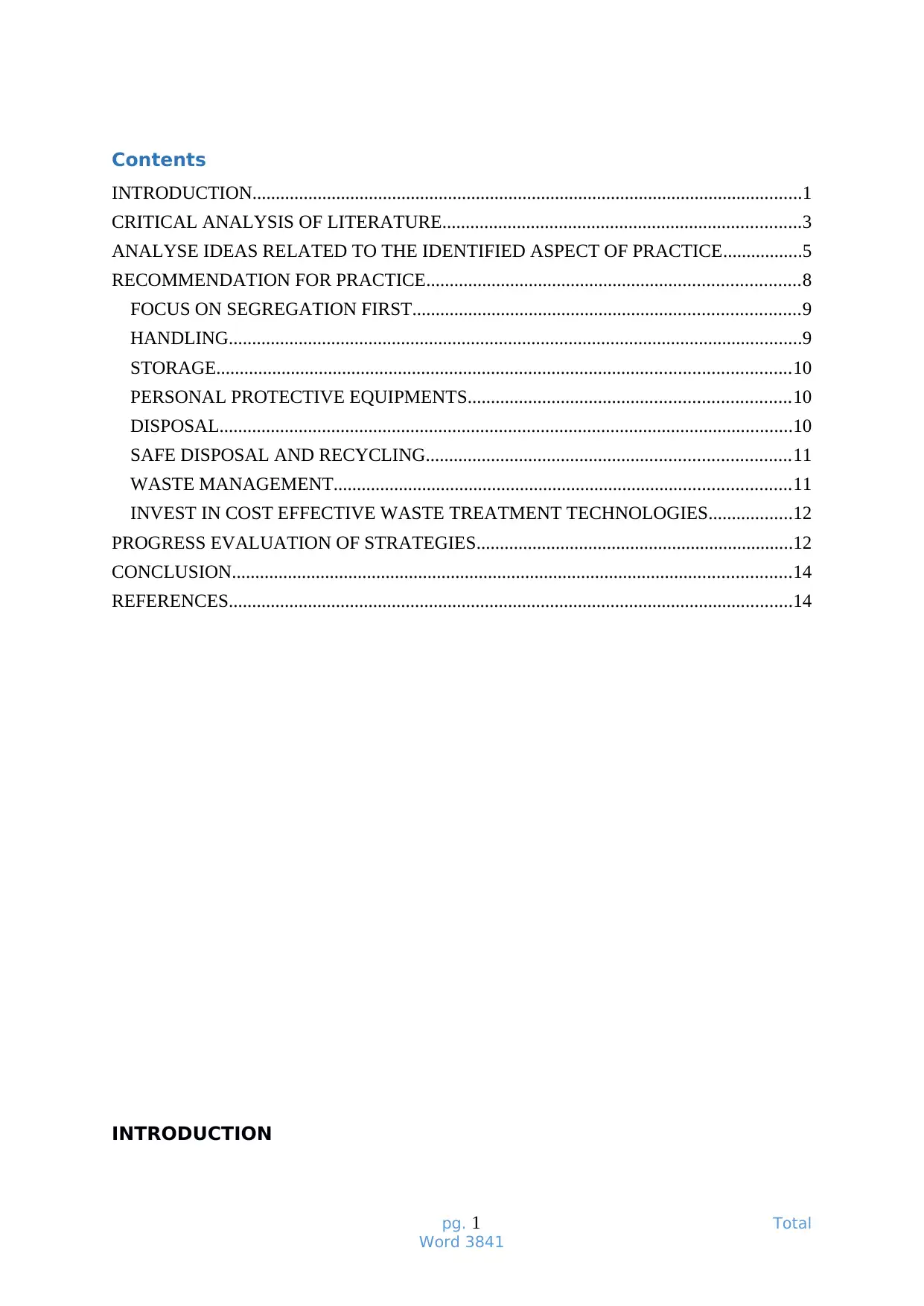
Contents
INTRODUCTION......................................................................................................................1
CRITICAL ANALYSIS OF LITERATURE.............................................................................3
ANALYSE IDEAS RELATED TO THE IDENTIFIED ASPECT OF PRACTICE.................5
RECOMMENDATION FOR PRACTICE................................................................................8
FOCUS ON SEGREGATION FIRST...................................................................................9
HANDLING...........................................................................................................................9
STORAGE...........................................................................................................................10
PERSONAL PROTECTIVE EQUIPMENTS.....................................................................10
DISPOSAL...........................................................................................................................10
SAFE DISPOSAL AND RECYCLING..............................................................................11
WASTE MANAGEMENT..................................................................................................11
INVEST IN COST EFFECTIVE WASTE TREATMENT TECHNOLOGIES..................12
PROGRESS EVALUATION OF STRATEGIES....................................................................12
CONCLUSION........................................................................................................................14
REFERENCES.........................................................................................................................14
INTRODUCTION
pg. 1 Total
Word 3841
INTRODUCTION......................................................................................................................1
CRITICAL ANALYSIS OF LITERATURE.............................................................................3
ANALYSE IDEAS RELATED TO THE IDENTIFIED ASPECT OF PRACTICE.................5
RECOMMENDATION FOR PRACTICE................................................................................8
FOCUS ON SEGREGATION FIRST...................................................................................9
HANDLING...........................................................................................................................9
STORAGE...........................................................................................................................10
PERSONAL PROTECTIVE EQUIPMENTS.....................................................................10
DISPOSAL...........................................................................................................................10
SAFE DISPOSAL AND RECYCLING..............................................................................11
WASTE MANAGEMENT..................................................................................................11
INVEST IN COST EFFECTIVE WASTE TREATMENT TECHNOLOGIES..................12
PROGRESS EVALUATION OF STRATEGIES....................................................................12
CONCLUSION........................................................................................................................14
REFERENCES.........................................................................................................................14
INTRODUCTION
pg. 1 Total
Word 3841
Paraphrase This Document
Need a fresh take? Get an instant paraphrase of this document with our AI Paraphraser
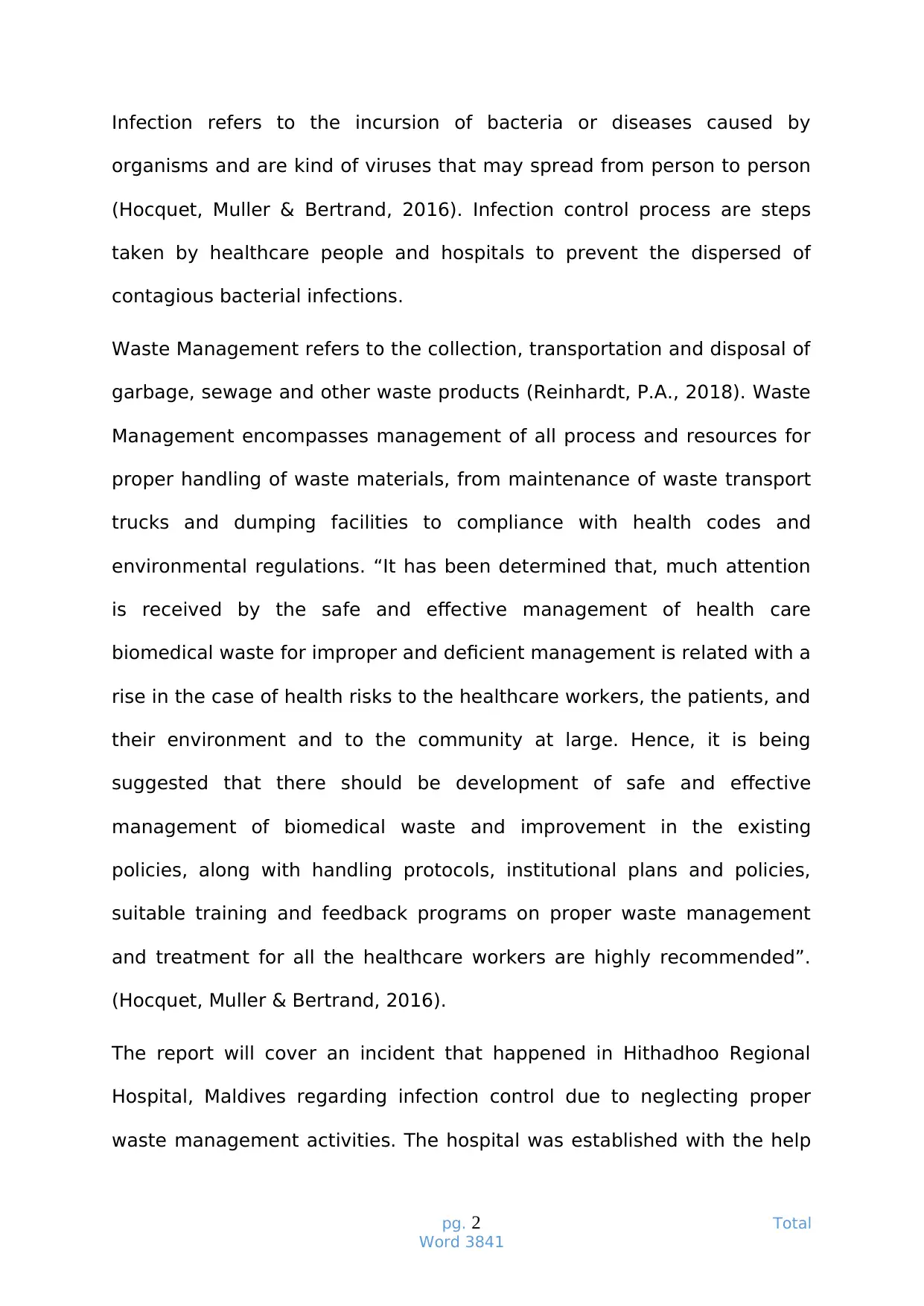
Infection refers to the incursion of bacteria or diseases caused by
organisms and are kind of viruses that may spread from person to person
(Hocquet, Muller & Bertrand, 2016). Infection control process are steps
taken by healthcare people and hospitals to prevent the dispersed of
contagious bacterial infections.
Waste Management refers to the collection, transportation and disposal of
garbage, sewage and other waste products (Reinhardt, P.A., 2018). Waste
Management encompasses management of all process and resources for
proper handling of waste materials, from maintenance of waste transport
trucks and dumping facilities to compliance with health codes and
environmental regulations. “It has been determined that, much attention
is received by the safe and effective management of health care
biomedical waste for improper and deficient management is related with a
rise in the case of health risks to the healthcare workers, the patients, and
their environment and to the community at large. Hence, it is being
suggested that there should be development of safe and effective
management of biomedical waste and improvement in the existing
policies, along with handling protocols, institutional plans and policies,
suitable training and feedback programs on proper waste management
and treatment for all the healthcare workers are highly recommended”.
(Hocquet, Muller & Bertrand, 2016).
The report will cover an incident that happened in Hithadhoo Regional
Hospital, Maldives regarding infection control due to neglecting proper
waste management activities. The hospital was established with the help
pg. 2 Total
Word 3841
organisms and are kind of viruses that may spread from person to person
(Hocquet, Muller & Bertrand, 2016). Infection control process are steps
taken by healthcare people and hospitals to prevent the dispersed of
contagious bacterial infections.
Waste Management refers to the collection, transportation and disposal of
garbage, sewage and other waste products (Reinhardt, P.A., 2018). Waste
Management encompasses management of all process and resources for
proper handling of waste materials, from maintenance of waste transport
trucks and dumping facilities to compliance with health codes and
environmental regulations. “It has been determined that, much attention
is received by the safe and effective management of health care
biomedical waste for improper and deficient management is related with a
rise in the case of health risks to the healthcare workers, the patients, and
their environment and to the community at large. Hence, it is being
suggested that there should be development of safe and effective
management of biomedical waste and improvement in the existing
policies, along with handling protocols, institutional plans and policies,
suitable training and feedback programs on proper waste management
and treatment for all the healthcare workers are highly recommended”.
(Hocquet, Muller & Bertrand, 2016).
The report will cover an incident that happened in Hithadhoo Regional
Hospital, Maldives regarding infection control due to neglecting proper
waste management activities. The hospital was established with the help
pg. 2 Total
Word 3841
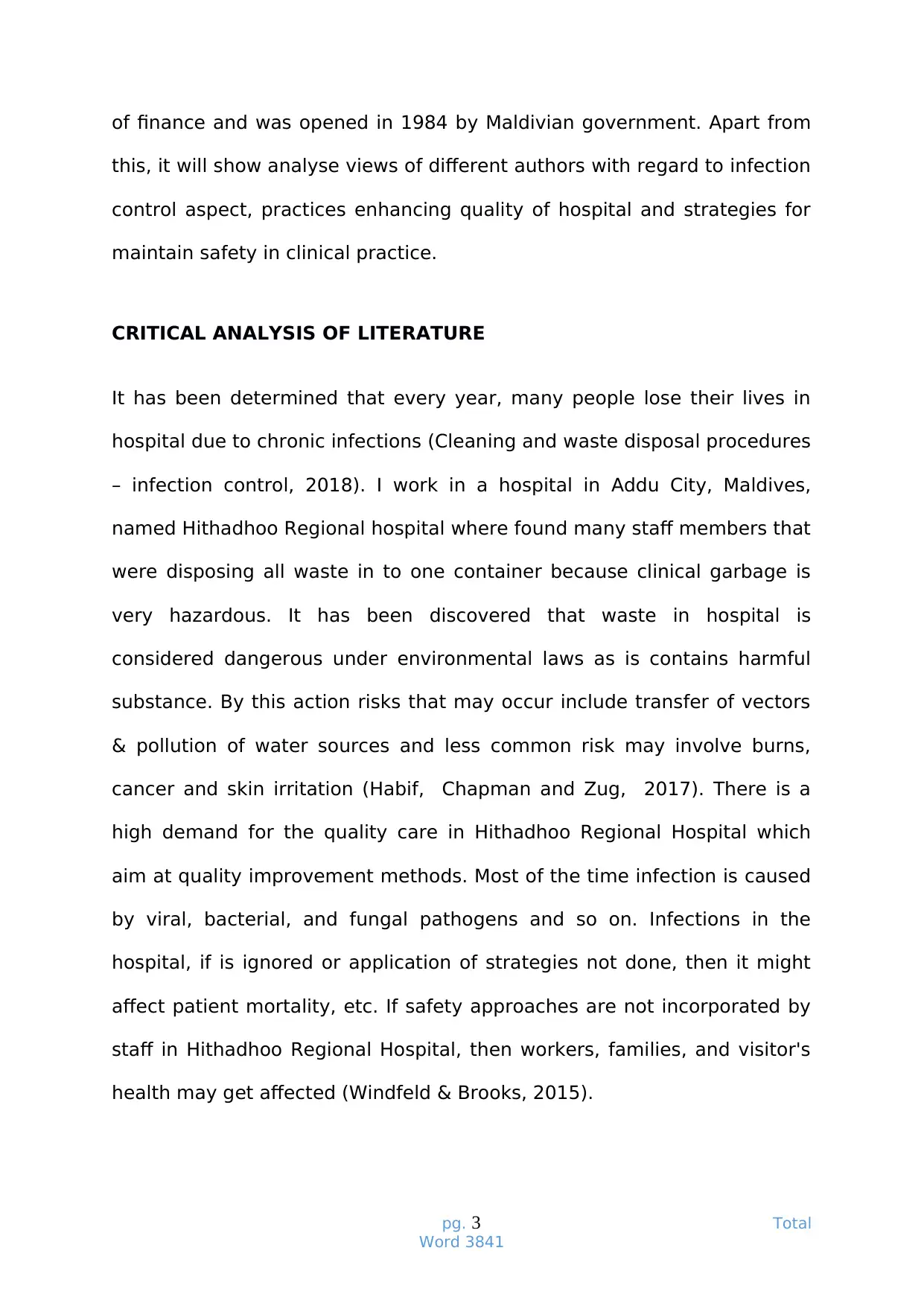
of finance and was opened in 1984 by Maldivian government. Apart from
this, it will show analyse views of different authors with regard to infection
control aspect, practices enhancing quality of hospital and strategies for
maintain safety in clinical practice.
CRITICAL ANALYSIS OF LITERATURE
It has been determined that every year, many people lose their lives in
hospital due to chronic infections (Cleaning and waste disposal procedures
– infection control, 2018). I work in a hospital in Addu City, Maldives,
named Hithadhoo Regional hospital where found many staff members that
were disposing all waste in to one container because clinical garbage is
very hazardous. It has been discovered that waste in hospital is
considered dangerous under environmental laws as is contains harmful
substance. By this action risks that may occur include transfer of vectors
& pollution of water sources and less common risk may involve burns,
cancer and skin irritation (Habif, Chapman and Zug, 2017). There is a
high demand for the quality care in Hithadhoo Regional Hospital which
aim at quality improvement methods. Most of the time infection is caused
by viral, bacterial, and fungal pathogens and so on. Infections in the
hospital, if is ignored or application of strategies not done, then it might
affect patient mortality, etc. If safety approaches are not incorporated by
staff in Hithadhoo Regional Hospital, then workers, families, and visitor's
health may get affected (Windfeld & Brooks, 2015).
pg. 3 Total
Word 3841
this, it will show analyse views of different authors with regard to infection
control aspect, practices enhancing quality of hospital and strategies for
maintain safety in clinical practice.
CRITICAL ANALYSIS OF LITERATURE
It has been determined that every year, many people lose their lives in
hospital due to chronic infections (Cleaning and waste disposal procedures
– infection control, 2018). I work in a hospital in Addu City, Maldives,
named Hithadhoo Regional hospital where found many staff members that
were disposing all waste in to one container because clinical garbage is
very hazardous. It has been discovered that waste in hospital is
considered dangerous under environmental laws as is contains harmful
substance. By this action risks that may occur include transfer of vectors
& pollution of water sources and less common risk may involve burns,
cancer and skin irritation (Habif, Chapman and Zug, 2017). There is a
high demand for the quality care in Hithadhoo Regional Hospital which
aim at quality improvement methods. Most of the time infection is caused
by viral, bacterial, and fungal pathogens and so on. Infections in the
hospital, if is ignored or application of strategies not done, then it might
affect patient mortality, etc. If safety approaches are not incorporated by
staff in Hithadhoo Regional Hospital, then workers, families, and visitor's
health may get affected (Windfeld & Brooks, 2015).
pg. 3 Total
Word 3841
⊘ This is a preview!⊘
Do you want full access?
Subscribe today to unlock all pages.

Trusted by 1+ million students worldwide
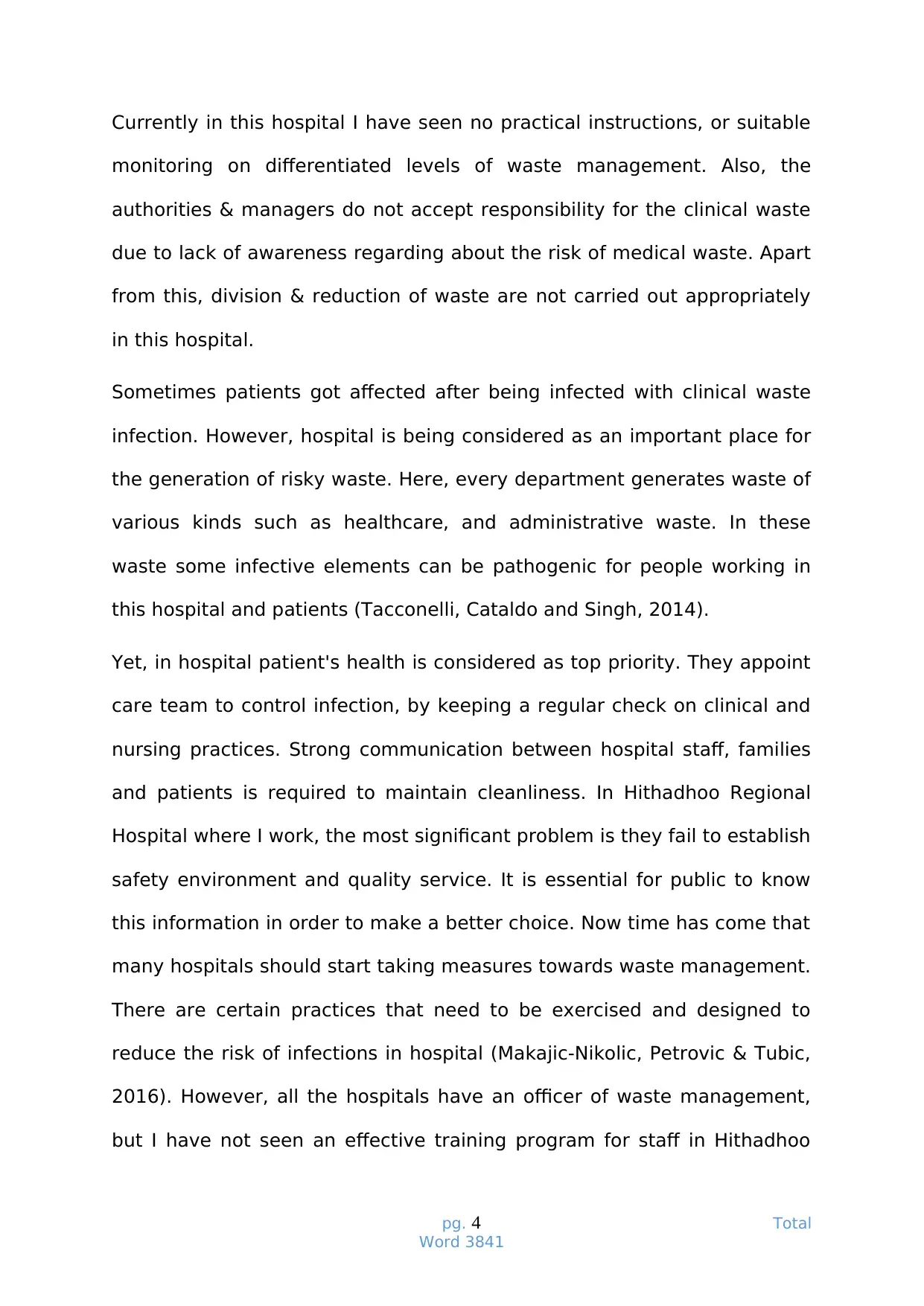
Currently in this hospital I have seen no practical instructions, or suitable
monitoring on differentiated levels of waste management. Also, the
authorities & managers do not accept responsibility for the clinical waste
due to lack of awareness regarding about the risk of medical waste. Apart
from this, division & reduction of waste are not carried out appropriately
in this hospital.
Sometimes patients got affected after being infected with clinical waste
infection. However, hospital is being considered as an important place for
the generation of risky waste. Here, every department generates waste of
various kinds such as healthcare, and administrative waste. In these
waste some infective elements can be pathogenic for people working in
this hospital and patients (Tacconelli, Cataldo and Singh, 2014).
Yet, in hospital patient's health is considered as top priority. They appoint
care team to control infection, by keeping a regular check on clinical and
nursing practices. Strong communication between hospital staff, families
and patients is required to maintain cleanliness. In Hithadhoo Regional
Hospital where I work, the most significant problem is they fail to establish
safety environment and quality service. It is essential for public to know
this information in order to make a better choice. Now time has come that
many hospitals should start taking measures towards waste management.
There are certain practices that need to be exercised and designed to
reduce the risk of infections in hospital (Makajic-Nikolic, Petrovic & Tubic,
2016). However, all the hospitals have an officer of waste management,
but I have not seen an effective training program for staff in Hithadhoo
pg. 4 Total
Word 3841
monitoring on differentiated levels of waste management. Also, the
authorities & managers do not accept responsibility for the clinical waste
due to lack of awareness regarding about the risk of medical waste. Apart
from this, division & reduction of waste are not carried out appropriately
in this hospital.
Sometimes patients got affected after being infected with clinical waste
infection. However, hospital is being considered as an important place for
the generation of risky waste. Here, every department generates waste of
various kinds such as healthcare, and administrative waste. In these
waste some infective elements can be pathogenic for people working in
this hospital and patients (Tacconelli, Cataldo and Singh, 2014).
Yet, in hospital patient's health is considered as top priority. They appoint
care team to control infection, by keeping a regular check on clinical and
nursing practices. Strong communication between hospital staff, families
and patients is required to maintain cleanliness. In Hithadhoo Regional
Hospital where I work, the most significant problem is they fail to establish
safety environment and quality service. It is essential for public to know
this information in order to make a better choice. Now time has come that
many hospitals should start taking measures towards waste management.
There are certain practices that need to be exercised and designed to
reduce the risk of infections in hospital (Makajic-Nikolic, Petrovic & Tubic,
2016). However, all the hospitals have an officer of waste management,
but I have not seen an effective training program for staff in Hithadhoo
pg. 4 Total
Word 3841
Paraphrase This Document
Need a fresh take? Get an instant paraphrase of this document with our AI Paraphraser
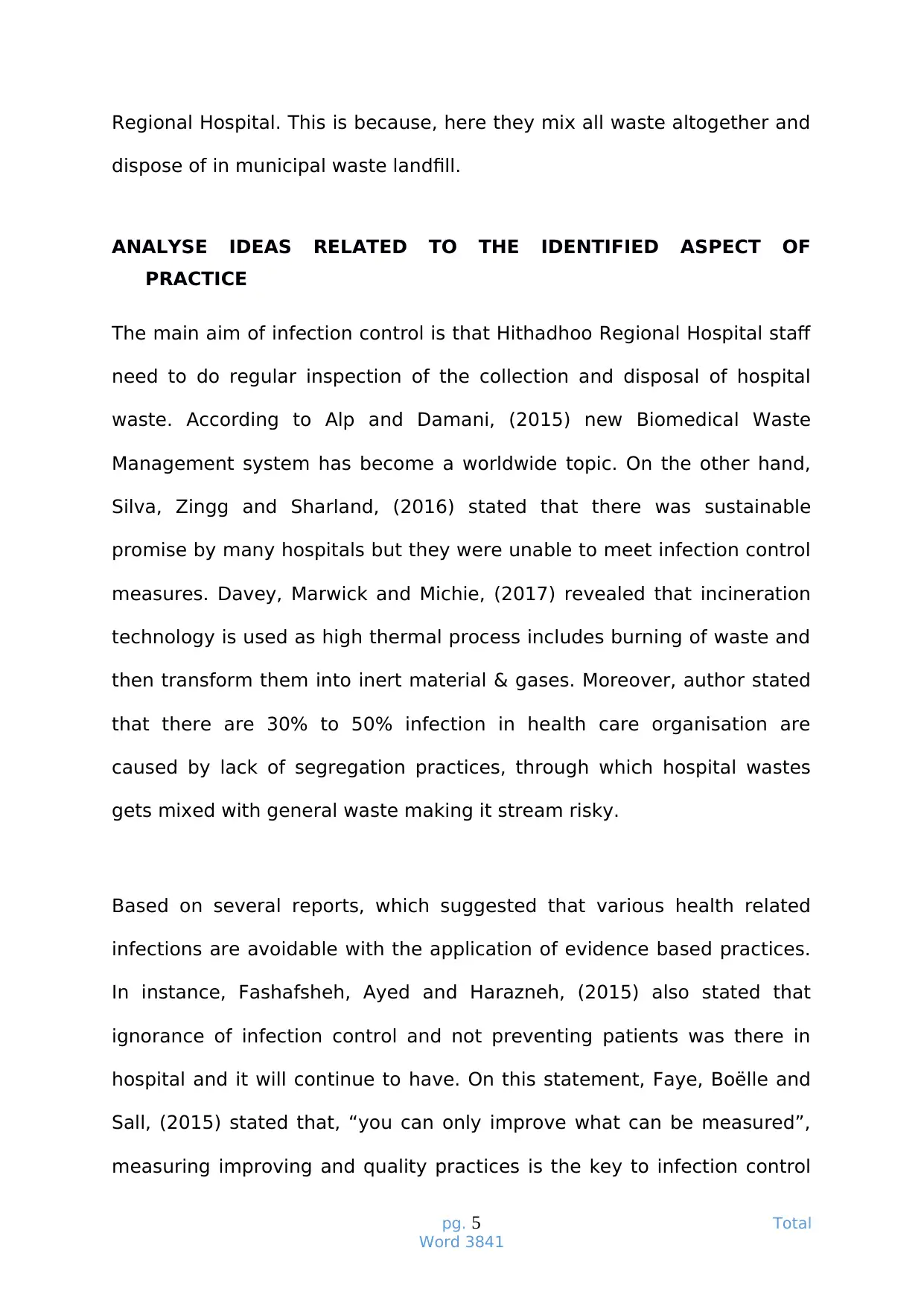
Regional Hospital. This is because, here they mix all waste altogether and
dispose of in municipal waste landfill.
ANALYSE IDEAS RELATED TO THE IDENTIFIED ASPECT OF
PRACTICE
The main aim of infection control is that Hithadhoo Regional Hospital staff
need to do regular inspection of the collection and disposal of hospital
waste. According to Alp and Damani, (2015) new Biomedical Waste
Management system has become a worldwide topic. On the other hand,
Silva, Zingg and Sharland, (2016) stated that there was sustainable
promise by many hospitals but they were unable to meet infection control
measures. Davey, Marwick and Michie, (2017) revealed that incineration
technology is used as high thermal process includes burning of waste and
then transform them into inert material & gases. Moreover, author stated
that there are 30% to 50% infection in health care organisation are
caused by lack of segregation practices, through which hospital wastes
gets mixed with general waste making it stream risky.
Based on several reports, which suggested that various health related
infections are avoidable with the application of evidence based practices.
In instance, Fashafsheh, Ayed and Harazneh, (2015) also stated that
ignorance of infection control and not preventing patients was there in
hospital and it will continue to have. On this statement, Faye, Boëlle and
Sall, (2015) stated that, “you can only improve what can be measured”,
measuring improving and quality practices is the key to infection control
pg. 5 Total
Word 3841
dispose of in municipal waste landfill.
ANALYSE IDEAS RELATED TO THE IDENTIFIED ASPECT OF
PRACTICE
The main aim of infection control is that Hithadhoo Regional Hospital staff
need to do regular inspection of the collection and disposal of hospital
waste. According to Alp and Damani, (2015) new Biomedical Waste
Management system has become a worldwide topic. On the other hand,
Silva, Zingg and Sharland, (2016) stated that there was sustainable
promise by many hospitals but they were unable to meet infection control
measures. Davey, Marwick and Michie, (2017) revealed that incineration
technology is used as high thermal process includes burning of waste and
then transform them into inert material & gases. Moreover, author stated
that there are 30% to 50% infection in health care organisation are
caused by lack of segregation practices, through which hospital wastes
gets mixed with general waste making it stream risky.
Based on several reports, which suggested that various health related
infections are avoidable with the application of evidence based practices.
In instance, Fashafsheh, Ayed and Harazneh, (2015) also stated that
ignorance of infection control and not preventing patients was there in
hospital and it will continue to have. On this statement, Faye, Boëlle and
Sall, (2015) stated that, “you can only improve what can be measured”,
measuring improving and quality practices is the key to infection control
pg. 5 Total
Word 3841
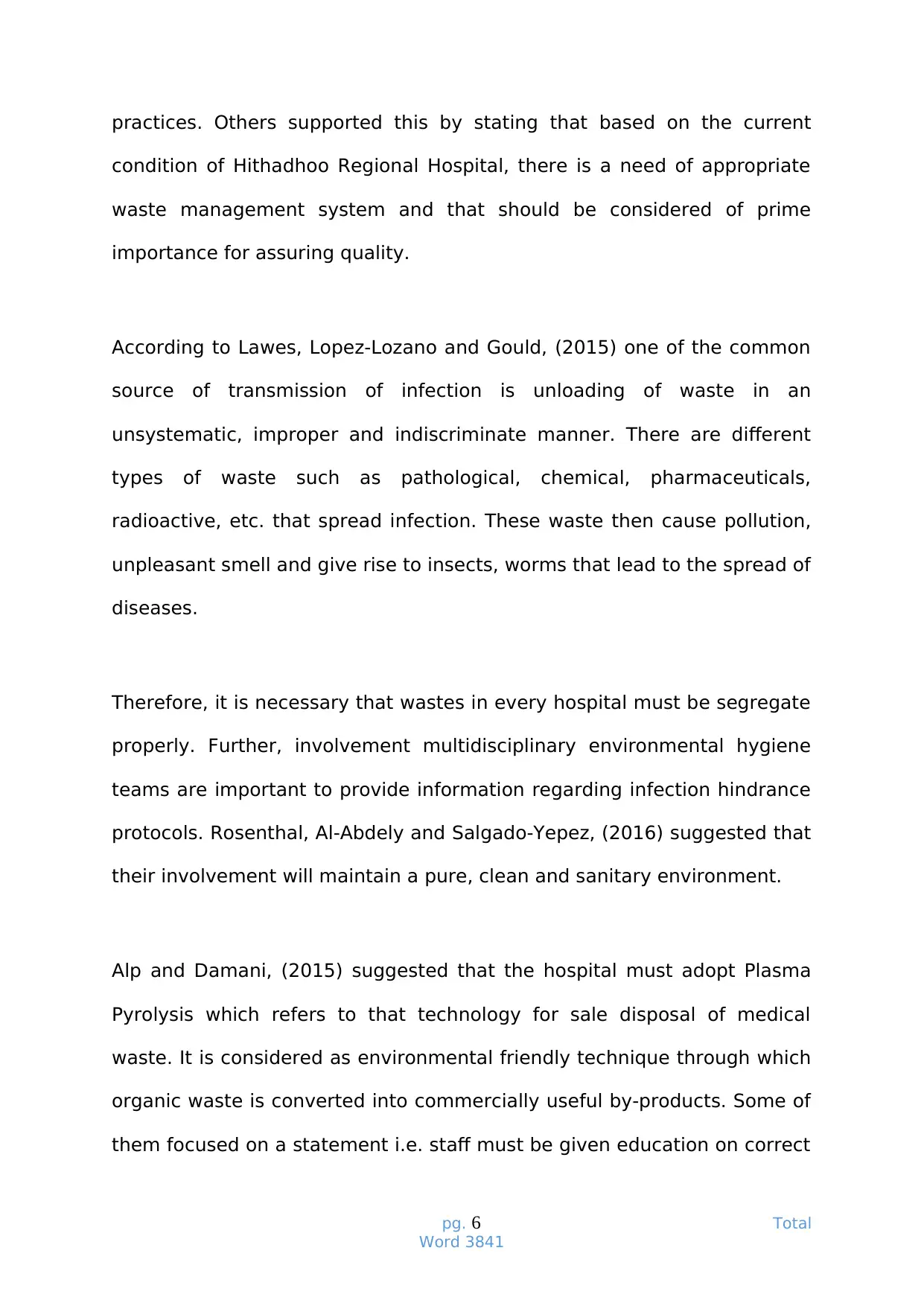
practices. Others supported this by stating that based on the current
condition of Hithadhoo Regional Hospital, there is a need of appropriate
waste management system and that should be considered of prime
importance for assuring quality.
According to Lawes, Lopez-Lozano and Gould, (2015) one of the common
source of transmission of infection is unloading of waste in an
unsystematic, improper and indiscriminate manner. There are different
types of waste such as pathological, chemical, pharmaceuticals,
radioactive, etc. that spread infection. These waste then cause pollution,
unpleasant smell and give rise to insects, worms that lead to the spread of
diseases.
Therefore, it is necessary that wastes in every hospital must be segregate
properly. Further, involvement multidisciplinary environmental hygiene
teams are important to provide information regarding infection hindrance
protocols. Rosenthal, Al-Abdely and Salgado-Yepez, (2016) suggested that
their involvement will maintain a pure, clean and sanitary environment.
Alp and Damani, (2015) suggested that the hospital must adopt Plasma
Pyrolysis which refers to that technology for sale disposal of medical
waste. It is considered as environmental friendly technique through which
organic waste is converted into commercially useful by-products. Some of
them focused on a statement i.e. staff must be given education on correct
pg. 6 Total
Word 3841
condition of Hithadhoo Regional Hospital, there is a need of appropriate
waste management system and that should be considered of prime
importance for assuring quality.
According to Lawes, Lopez-Lozano and Gould, (2015) one of the common
source of transmission of infection is unloading of waste in an
unsystematic, improper and indiscriminate manner. There are different
types of waste such as pathological, chemical, pharmaceuticals,
radioactive, etc. that spread infection. These waste then cause pollution,
unpleasant smell and give rise to insects, worms that lead to the spread of
diseases.
Therefore, it is necessary that wastes in every hospital must be segregate
properly. Further, involvement multidisciplinary environmental hygiene
teams are important to provide information regarding infection hindrance
protocols. Rosenthal, Al-Abdely and Salgado-Yepez, (2016) suggested that
their involvement will maintain a pure, clean and sanitary environment.
Alp and Damani, (2015) suggested that the hospital must adopt Plasma
Pyrolysis which refers to that technology for sale disposal of medical
waste. It is considered as environmental friendly technique through which
organic waste is converted into commercially useful by-products. Some of
them focused on a statement i.e. staff must be given education on correct
pg. 6 Total
Word 3841
⊘ This is a preview!⊘
Do you want full access?
Subscribe today to unlock all pages.

Trusted by 1+ million students worldwide
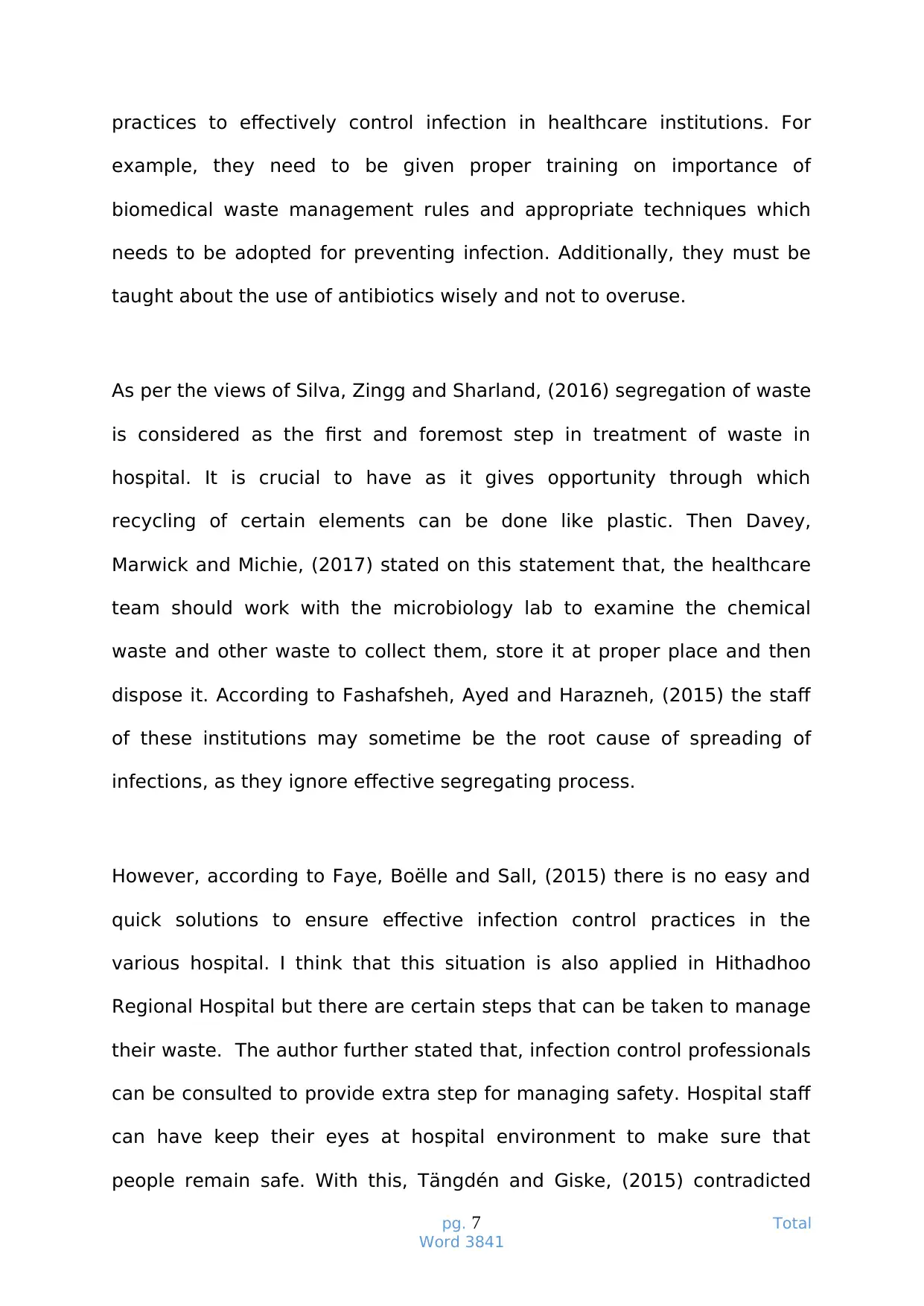
practices to effectively control infection in healthcare institutions. For
example, they need to be given proper training on importance of
biomedical waste management rules and appropriate techniques which
needs to be adopted for preventing infection. Additionally, they must be
taught about the use of antibiotics wisely and not to overuse.
As per the views of Silva, Zingg and Sharland, (2016) segregation of waste
is considered as the first and foremost step in treatment of waste in
hospital. It is crucial to have as it gives opportunity through which
recycling of certain elements can be done like plastic. Then Davey,
Marwick and Michie, (2017) stated on this statement that, the healthcare
team should work with the microbiology lab to examine the chemical
waste and other waste to collect them, store it at proper place and then
dispose it. According to Fashafsheh, Ayed and Harazneh, (2015) the staff
of these institutions may sometime be the root cause of spreading of
infections, as they ignore effective segregating process.
However, according to Faye, Boëlle and Sall, (2015) there is no easy and
quick solutions to ensure effective infection control practices in the
various hospital. I think that this situation is also applied in Hithadhoo
Regional Hospital but there are certain steps that can be taken to manage
their waste. The author further stated that, infection control professionals
can be consulted to provide extra step for managing safety. Hospital staff
can have keep their eyes at hospital environment to make sure that
people remain safe. With this, Tängdén and Giske, (2015) contradicted
pg. 7 Total
Word 3841
example, they need to be given proper training on importance of
biomedical waste management rules and appropriate techniques which
needs to be adopted for preventing infection. Additionally, they must be
taught about the use of antibiotics wisely and not to overuse.
As per the views of Silva, Zingg and Sharland, (2016) segregation of waste
is considered as the first and foremost step in treatment of waste in
hospital. It is crucial to have as it gives opportunity through which
recycling of certain elements can be done like plastic. Then Davey,
Marwick and Michie, (2017) stated on this statement that, the healthcare
team should work with the microbiology lab to examine the chemical
waste and other waste to collect them, store it at proper place and then
dispose it. According to Fashafsheh, Ayed and Harazneh, (2015) the staff
of these institutions may sometime be the root cause of spreading of
infections, as they ignore effective segregating process.
However, according to Faye, Boëlle and Sall, (2015) there is no easy and
quick solutions to ensure effective infection control practices in the
various hospital. I think that this situation is also applied in Hithadhoo
Regional Hospital but there are certain steps that can be taken to manage
their waste. The author further stated that, infection control professionals
can be consulted to provide extra step for managing safety. Hospital staff
can have keep their eyes at hospital environment to make sure that
people remain safe. With this, Tängdén and Giske, (2015) contradicted
pg. 7 Total
Word 3841
Paraphrase This Document
Need a fresh take? Get an instant paraphrase of this document with our AI Paraphraser
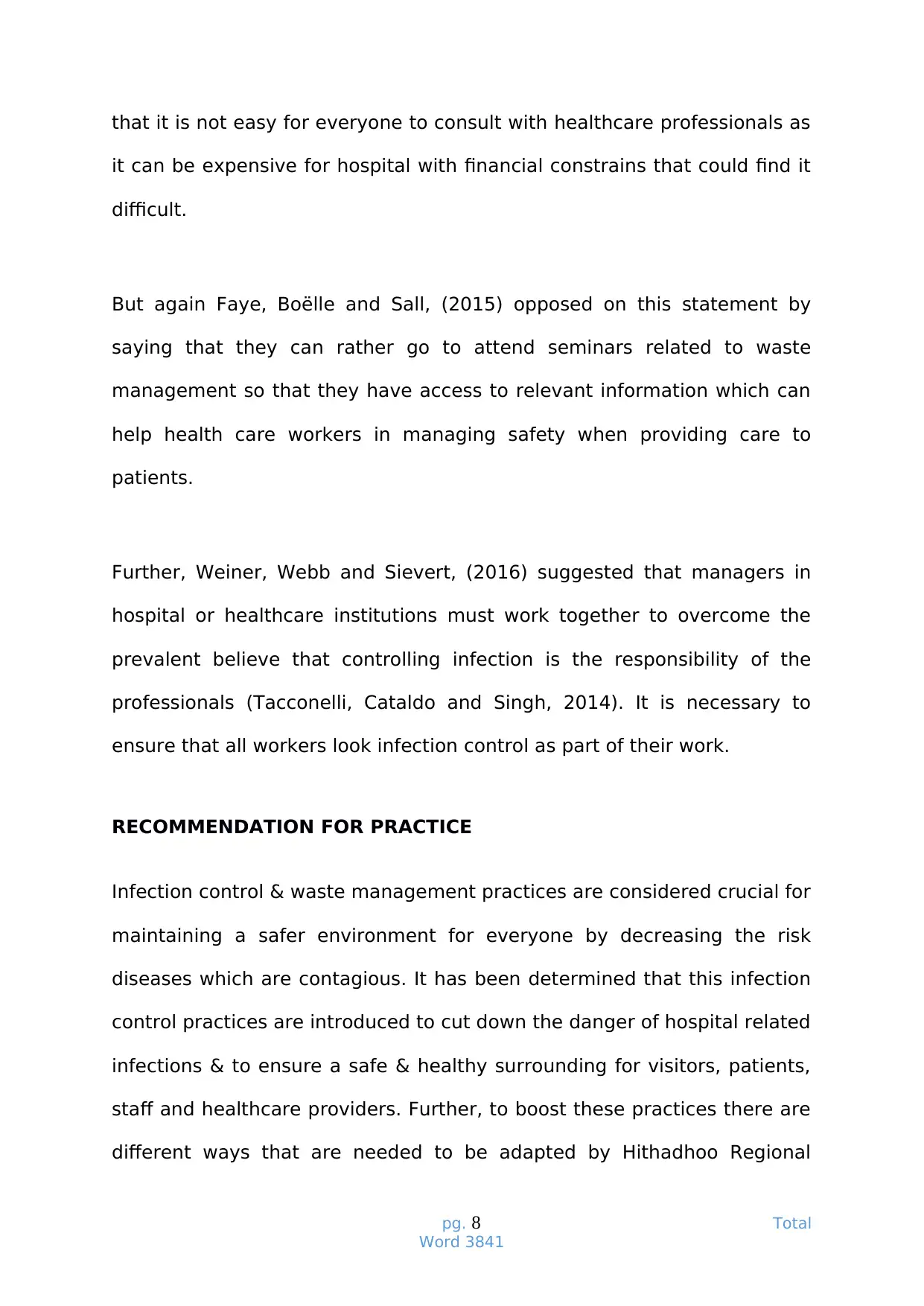
that it is not easy for everyone to consult with healthcare professionals as
it can be expensive for hospital with financial constrains that could find it
difficult.
But again Faye, Boëlle and Sall, (2015) opposed on this statement by
saying that they can rather go to attend seminars related to waste
management so that they have access to relevant information which can
help health care workers in managing safety when providing care to
patients.
Further, Weiner, Webb and Sievert, (2016) suggested that managers in
hospital or healthcare institutions must work together to overcome the
prevalent believe that controlling infection is the responsibility of the
professionals (Tacconelli, Cataldo and Singh, 2014). It is necessary to
ensure that all workers look infection control as part of their work.
RECOMMENDATION FOR PRACTICE
Infection control & waste management practices are considered crucial for
maintaining a safer environment for everyone by decreasing the risk
diseases which are contagious. It has been determined that this infection
control practices are introduced to cut down the danger of hospital related
infections & to ensure a safe & healthy surrounding for visitors, patients,
staff and healthcare providers. Further, to boost these practices there are
different ways that are needed to be adapted by Hithadhoo Regional
pg. 8 Total
Word 3841
it can be expensive for hospital with financial constrains that could find it
difficult.
But again Faye, Boëlle and Sall, (2015) opposed on this statement by
saying that they can rather go to attend seminars related to waste
management so that they have access to relevant information which can
help health care workers in managing safety when providing care to
patients.
Further, Weiner, Webb and Sievert, (2016) suggested that managers in
hospital or healthcare institutions must work together to overcome the
prevalent believe that controlling infection is the responsibility of the
professionals (Tacconelli, Cataldo and Singh, 2014). It is necessary to
ensure that all workers look infection control as part of their work.
RECOMMENDATION FOR PRACTICE
Infection control & waste management practices are considered crucial for
maintaining a safer environment for everyone by decreasing the risk
diseases which are contagious. It has been determined that this infection
control practices are introduced to cut down the danger of hospital related
infections & to ensure a safe & healthy surrounding for visitors, patients,
staff and healthcare providers. Further, to boost these practices there are
different ways that are needed to be adapted by Hithadhoo Regional
pg. 8 Total
Word 3841
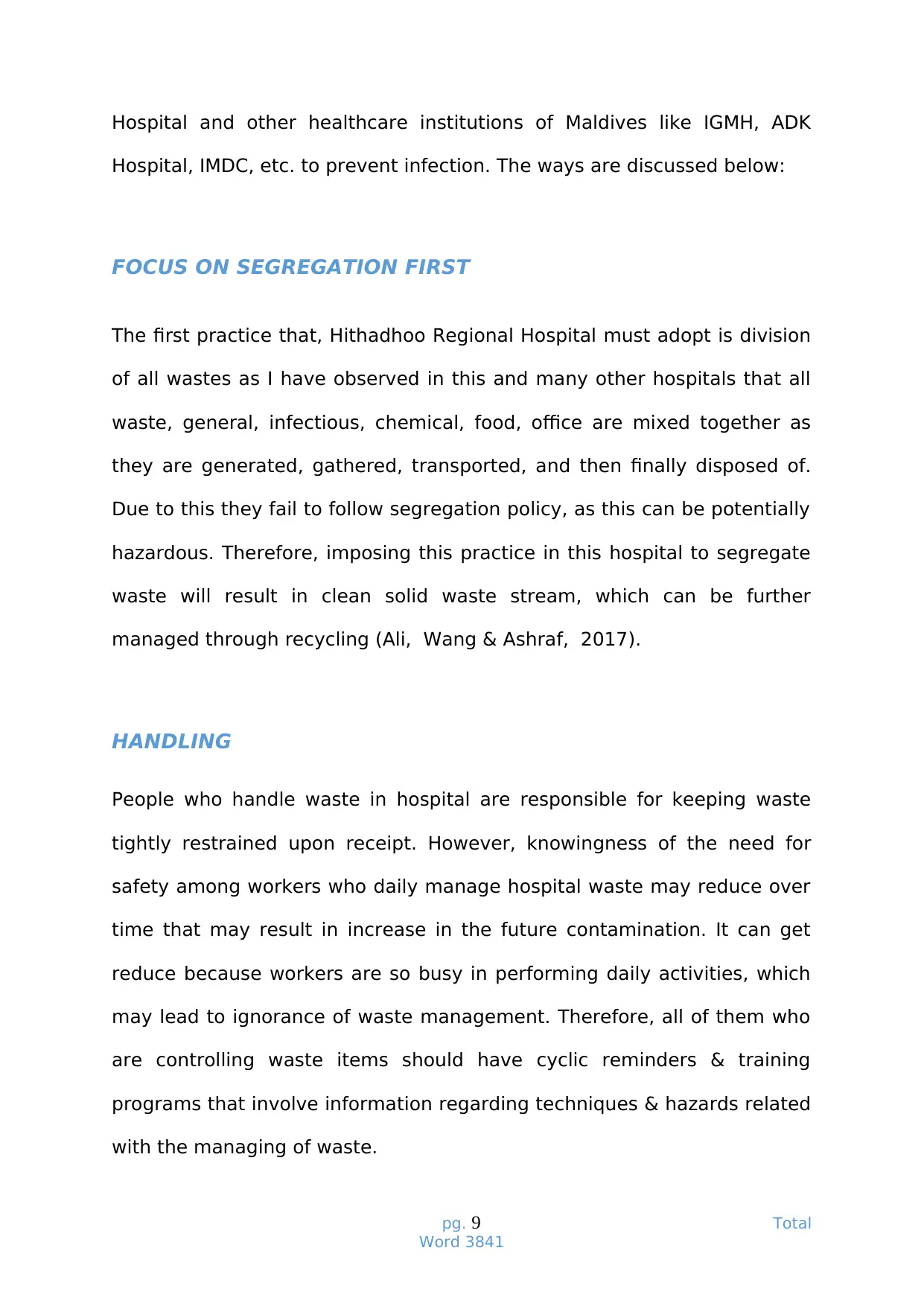
Hospital and other healthcare institutions of Maldives like IGMH, ADK
Hospital, IMDC, etc. to prevent infection. The ways are discussed below:
FOCUS ON SEGREGATION FIRST
The first practice that, Hithadhoo Regional Hospital must adopt is division
of all wastes as I have observed in this and many other hospitals that all
waste, general, infectious, chemical, food, office are mixed together as
they are generated, gathered, transported, and then finally disposed of.
Due to this they fail to follow segregation policy, as this can be potentially
hazardous. Therefore, imposing this practice in this hospital to segregate
waste will result in clean solid waste stream, which can be further
managed through recycling (Ali, Wang & Ashraf, 2017).
HANDLING
People who handle waste in hospital are responsible for keeping waste
tightly restrained upon receipt. However, knowingness of the need for
safety among workers who daily manage hospital waste may reduce over
time that may result in increase in the future contamination. It can get
reduce because workers are so busy in performing daily activities, which
may lead to ignorance of waste management. Therefore, all of them who
are controlling waste items should have cyclic reminders & training
programs that involve information regarding techniques & hazards related
with the managing of waste.
pg. 9 Total
Word 3841
Hospital, IMDC, etc. to prevent infection. The ways are discussed below:
FOCUS ON SEGREGATION FIRST
The first practice that, Hithadhoo Regional Hospital must adopt is division
of all wastes as I have observed in this and many other hospitals that all
waste, general, infectious, chemical, food, office are mixed together as
they are generated, gathered, transported, and then finally disposed of.
Due to this they fail to follow segregation policy, as this can be potentially
hazardous. Therefore, imposing this practice in this hospital to segregate
waste will result in clean solid waste stream, which can be further
managed through recycling (Ali, Wang & Ashraf, 2017).
HANDLING
People who handle waste in hospital are responsible for keeping waste
tightly restrained upon receipt. However, knowingness of the need for
safety among workers who daily manage hospital waste may reduce over
time that may result in increase in the future contamination. It can get
reduce because workers are so busy in performing daily activities, which
may lead to ignorance of waste management. Therefore, all of them who
are controlling waste items should have cyclic reminders & training
programs that involve information regarding techniques & hazards related
with the managing of waste.
pg. 9 Total
Word 3841
⊘ This is a preview!⊘
Do you want full access?
Subscribe today to unlock all pages.

Trusted by 1+ million students worldwide
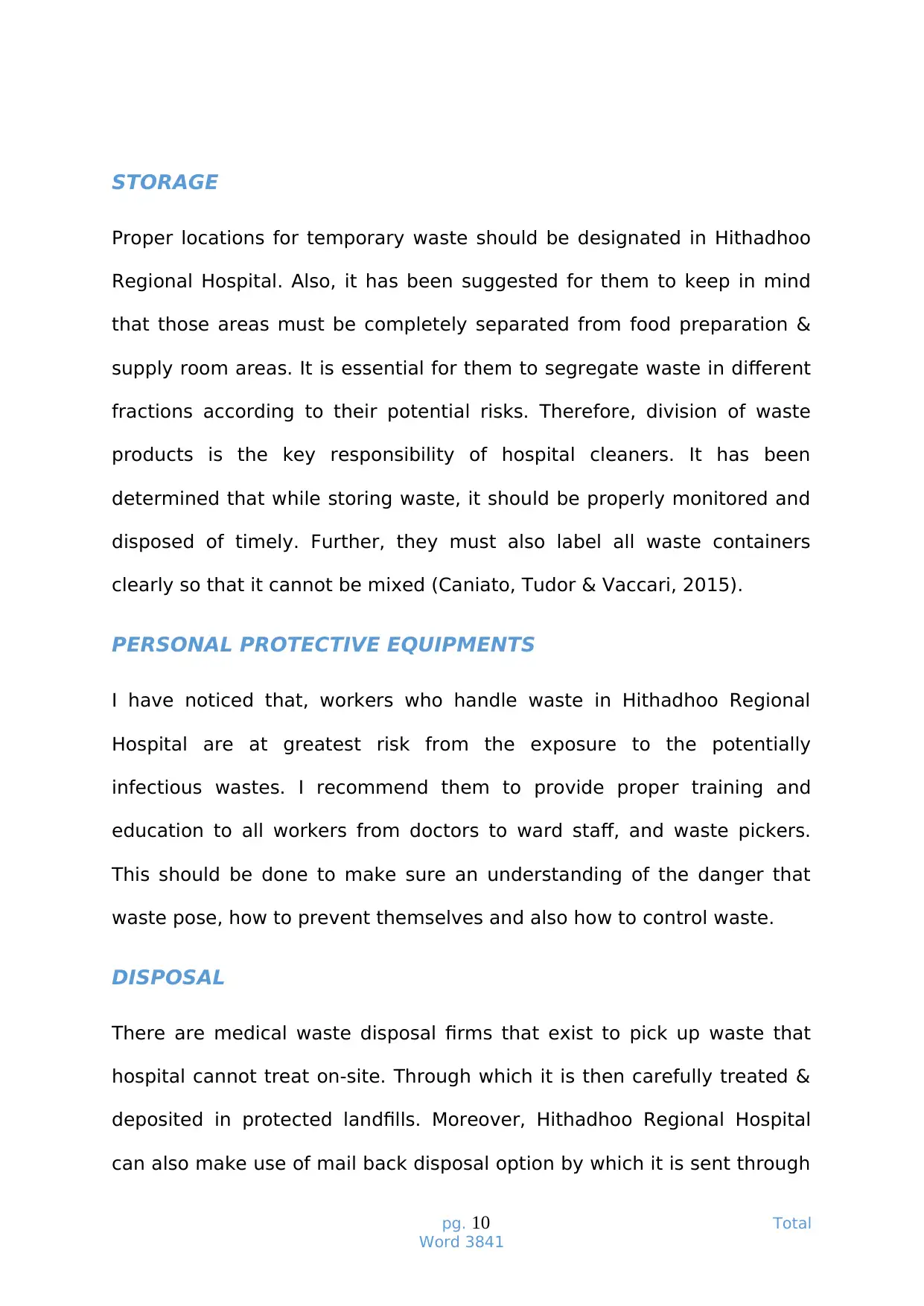
STORAGE
Proper locations for temporary waste should be designated in Hithadhoo
Regional Hospital. Also, it has been suggested for them to keep in mind
that those areas must be completely separated from food preparation &
supply room areas. It is essential for them to segregate waste in different
fractions according to their potential risks. Therefore, division of waste
products is the key responsibility of hospital cleaners. It has been
determined that while storing waste, it should be properly monitored and
disposed of timely. Further, they must also label all waste containers
clearly so that it cannot be mixed (Caniato, Tudor & Vaccari, 2015).
PERSONAL PROTECTIVE EQUIPMENTS
I have noticed that, workers who handle waste in Hithadhoo Regional
Hospital are at greatest risk from the exposure to the potentially
infectious wastes. I recommend them to provide proper training and
education to all workers from doctors to ward staff, and waste pickers.
This should be done to make sure an understanding of the danger that
waste pose, how to prevent themselves and also how to control waste.
DISPOSAL
There are medical waste disposal firms that exist to pick up waste that
hospital cannot treat on-site. Through which it is then carefully treated &
deposited in protected landfills. Moreover, Hithadhoo Regional Hospital
can also make use of mail back disposal option by which it is sent through
pg. 10 Total
Word 3841
Proper locations for temporary waste should be designated in Hithadhoo
Regional Hospital. Also, it has been suggested for them to keep in mind
that those areas must be completely separated from food preparation &
supply room areas. It is essential for them to segregate waste in different
fractions according to their potential risks. Therefore, division of waste
products is the key responsibility of hospital cleaners. It has been
determined that while storing waste, it should be properly monitored and
disposed of timely. Further, they must also label all waste containers
clearly so that it cannot be mixed (Caniato, Tudor & Vaccari, 2015).
PERSONAL PROTECTIVE EQUIPMENTS
I have noticed that, workers who handle waste in Hithadhoo Regional
Hospital are at greatest risk from the exposure to the potentially
infectious wastes. I recommend them to provide proper training and
education to all workers from doctors to ward staff, and waste pickers.
This should be done to make sure an understanding of the danger that
waste pose, how to prevent themselves and also how to control waste.
DISPOSAL
There are medical waste disposal firms that exist to pick up waste that
hospital cannot treat on-site. Through which it is then carefully treated &
deposited in protected landfills. Moreover, Hithadhoo Regional Hospital
can also make use of mail back disposal option by which it is sent through
pg. 10 Total
Word 3841
Paraphrase This Document
Need a fresh take? Get an instant paraphrase of this document with our AI Paraphraser
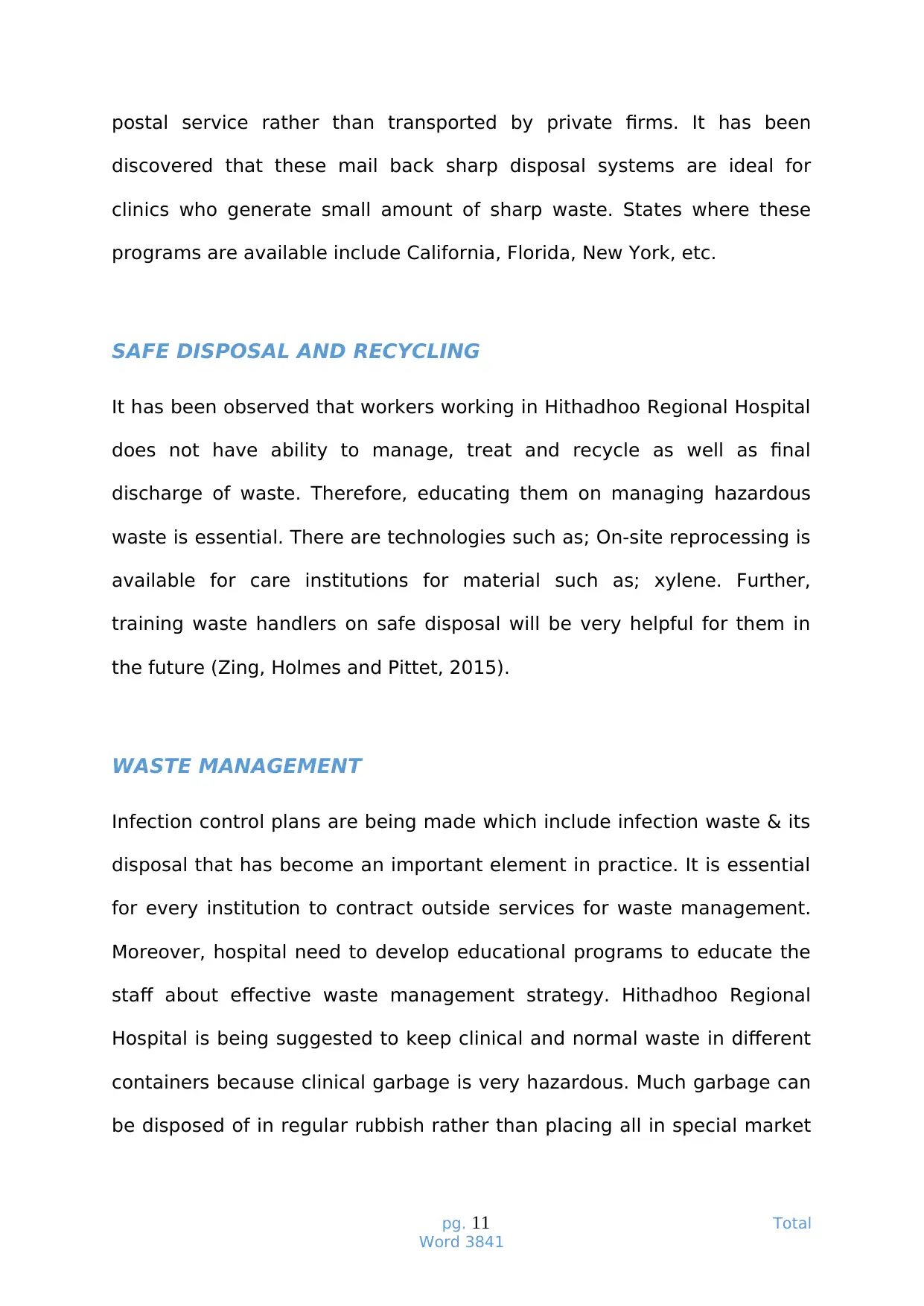
postal service rather than transported by private firms. It has been
discovered that these mail back sharp disposal systems are ideal for
clinics who generate small amount of sharp waste. States where these
programs are available include California, Florida, New York, etc.
SAFE DISPOSAL AND RECYCLING
It has been observed that workers working in Hithadhoo Regional Hospital
does not have ability to manage, treat and recycle as well as final
discharge of waste. Therefore, educating them on managing hazardous
waste is essential. There are technologies such as; On-site reprocessing is
available for care institutions for material such as; xylene. Further,
training waste handlers on safe disposal will be very helpful for them in
the future (Zing, Holmes and Pittet, 2015).
WASTE MANAGEMENT
Infection control plans are being made which include infection waste & its
disposal that has become an important element in practice. It is essential
for every institution to contract outside services for waste management.
Moreover, hospital need to develop educational programs to educate the
staff about effective waste management strategy. Hithadhoo Regional
Hospital is being suggested to keep clinical and normal waste in different
containers because clinical garbage is very hazardous. Much garbage can
be disposed of in regular rubbish rather than placing all in special market
pg. 11 Total
Word 3841
discovered that these mail back sharp disposal systems are ideal for
clinics who generate small amount of sharp waste. States where these
programs are available include California, Florida, New York, etc.
SAFE DISPOSAL AND RECYCLING
It has been observed that workers working in Hithadhoo Regional Hospital
does not have ability to manage, treat and recycle as well as final
discharge of waste. Therefore, educating them on managing hazardous
waste is essential. There are technologies such as; On-site reprocessing is
available for care institutions for material such as; xylene. Further,
training waste handlers on safe disposal will be very helpful for them in
the future (Zing, Holmes and Pittet, 2015).
WASTE MANAGEMENT
Infection control plans are being made which include infection waste & its
disposal that has become an important element in practice. It is essential
for every institution to contract outside services for waste management.
Moreover, hospital need to develop educational programs to educate the
staff about effective waste management strategy. Hithadhoo Regional
Hospital is being suggested to keep clinical and normal waste in different
containers because clinical garbage is very hazardous. Much garbage can
be disposed of in regular rubbish rather than placing all in special market
pg. 11 Total
Word 3841
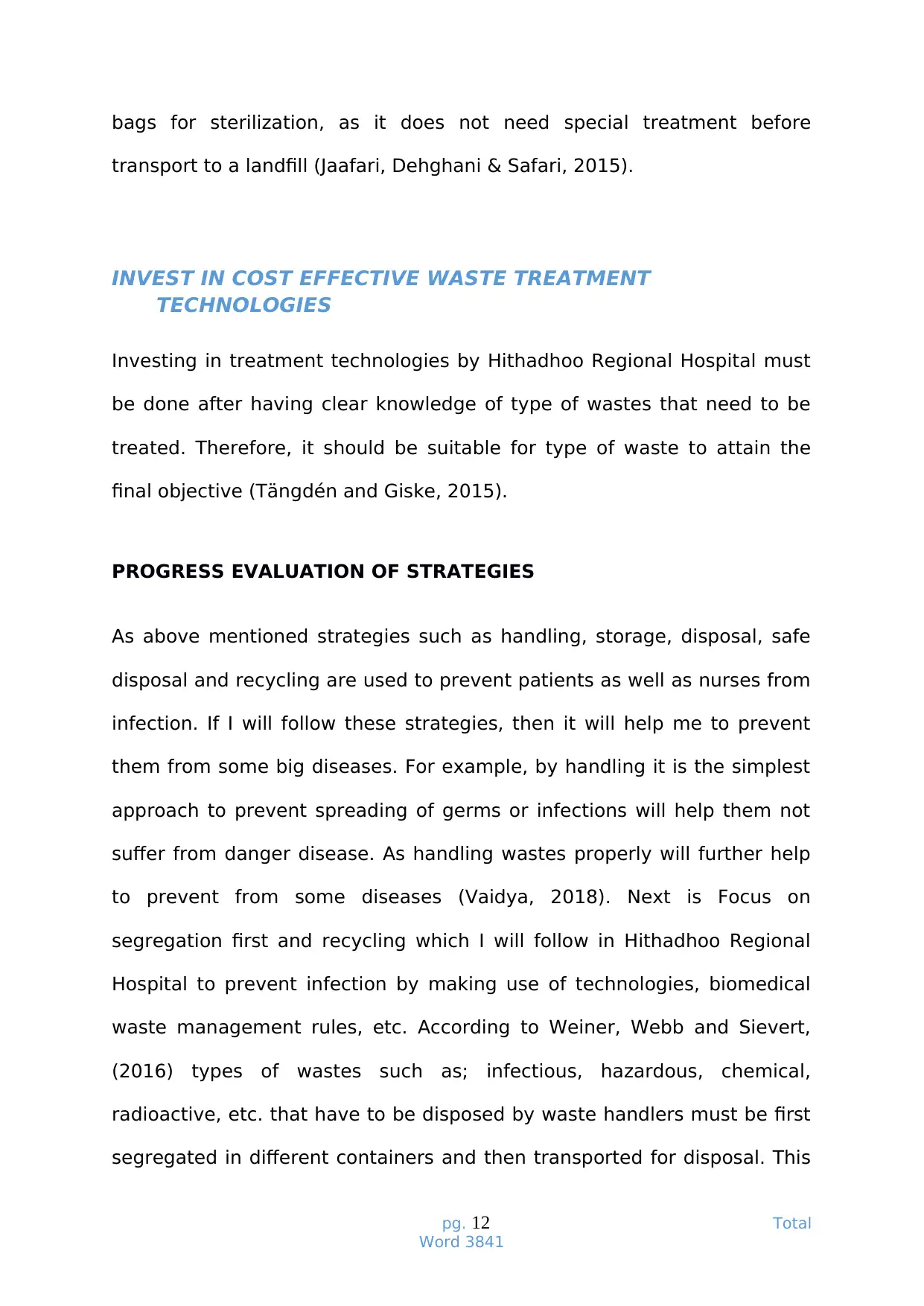
bags for sterilization, as it does not need special treatment before
transport to a landfill (Jaafari, Dehghani & Safari, 2015).
INVEST IN COST EFFECTIVE WASTE TREATMENT
TECHNOLOGIES
Investing in treatment technologies by Hithadhoo Regional Hospital must
be done after having clear knowledge of type of wastes that need to be
treated. Therefore, it should be suitable for type of waste to attain the
final objective (Tängdén and Giske, 2015).
PROGRESS EVALUATION OF STRATEGIES
As above mentioned strategies such as handling, storage, disposal, safe
disposal and recycling are used to prevent patients as well as nurses from
infection. If I will follow these strategies, then it will help me to prevent
them from some big diseases. For example, by handling it is the simplest
approach to prevent spreading of germs or infections will help them not
suffer from danger disease. As handling wastes properly will further help
to prevent from some diseases (Vaidya, 2018). Next is Focus on
segregation first and recycling which I will follow in Hithadhoo Regional
Hospital to prevent infection by making use of technologies, biomedical
waste management rules, etc. According to Weiner, Webb and Sievert,
(2016) types of wastes such as; infectious, hazardous, chemical,
radioactive, etc. that have to be disposed by waste handlers must be first
segregated in different containers and then transported for disposal. This
pg. 12 Total
Word 3841
transport to a landfill (Jaafari, Dehghani & Safari, 2015).
INVEST IN COST EFFECTIVE WASTE TREATMENT
TECHNOLOGIES
Investing in treatment technologies by Hithadhoo Regional Hospital must
be done after having clear knowledge of type of wastes that need to be
treated. Therefore, it should be suitable for type of waste to attain the
final objective (Tängdén and Giske, 2015).
PROGRESS EVALUATION OF STRATEGIES
As above mentioned strategies such as handling, storage, disposal, safe
disposal and recycling are used to prevent patients as well as nurses from
infection. If I will follow these strategies, then it will help me to prevent
them from some big diseases. For example, by handling it is the simplest
approach to prevent spreading of germs or infections will help them not
suffer from danger disease. As handling wastes properly will further help
to prevent from some diseases (Vaidya, 2018). Next is Focus on
segregation first and recycling which I will follow in Hithadhoo Regional
Hospital to prevent infection by making use of technologies, biomedical
waste management rules, etc. According to Weiner, Webb and Sievert,
(2016) types of wastes such as; infectious, hazardous, chemical,
radioactive, etc. that have to be disposed by waste handlers must be first
segregated in different containers and then transported for disposal. This
pg. 12 Total
Word 3841
⊘ This is a preview!⊘
Do you want full access?
Subscribe today to unlock all pages.

Trusted by 1+ million students worldwide
1 out of 19
Related Documents
Your All-in-One AI-Powered Toolkit for Academic Success.
+13062052269
info@desklib.com
Available 24*7 on WhatsApp / Email
![[object Object]](/_next/static/media/star-bottom.7253800d.svg)
Unlock your academic potential
Copyright © 2020–2025 A2Z Services. All Rights Reserved. Developed and managed by ZUCOL.





